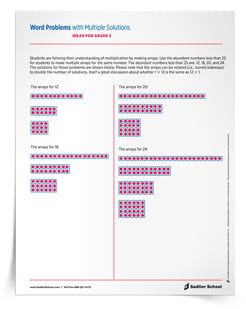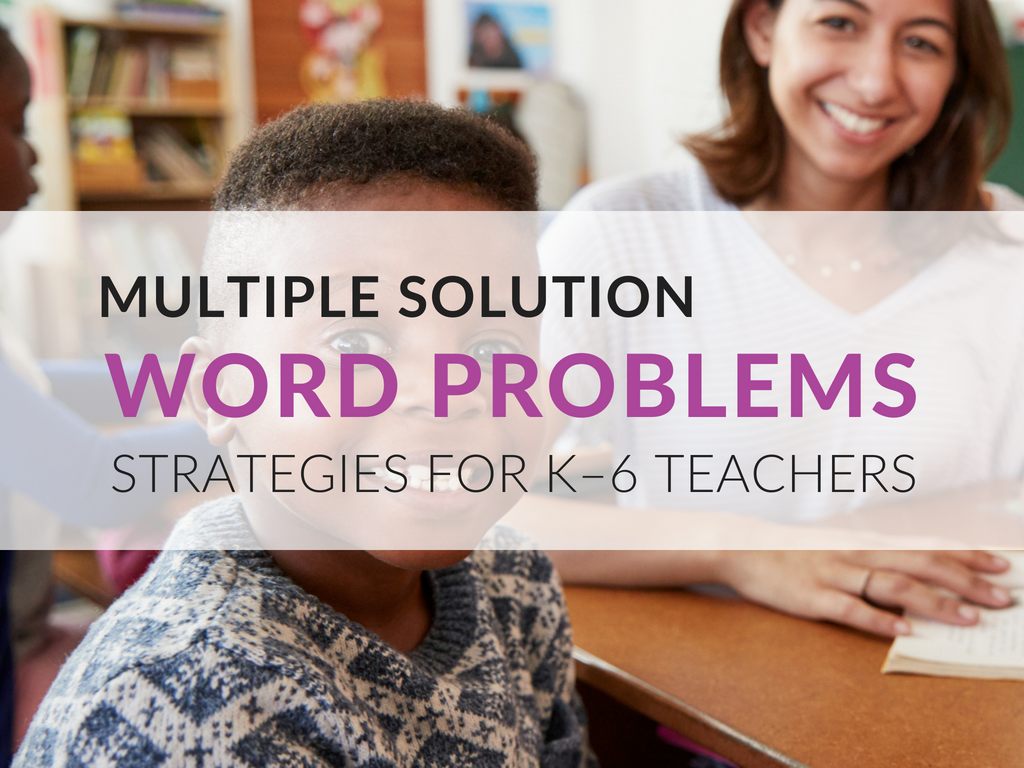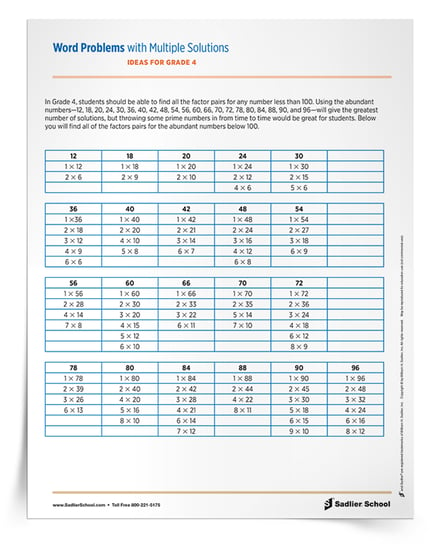January 21, 2025 3-5-operations-and-algebraic-thinking, k-2-operations-and-algebraic-thinking
Word Problem Strategies for Teachers– Problems with Multiple Solutions in K–6
By: Jeff Todd
Whether you are teaching the youngest or oldest of the elementary school population, solving word problems with multiple solutions is a great way to get students thinking about numbers. After all, life is full of problems that can have more than one solution! In this article, we'll explore word problem strategies, engineering great classroom discussions, and how to create a word problem with multiple solutions for each grade level. Plus, I've created a free download that outlines math word problem examples for each grade level.
Multiple Solution Word Problem Strategies
The Benefits Of Word Problems With Multiple Solutions
One of the greatest ways to engage students in “true problem solving” is to give them math word problems with multiple solutions. This is possible at all grade levels and will help students with their problems solving ability. Students think it's fun and will even compete with each other to find new and different ways to come up with multiple solutions. An added benefit of word problems with multiple solutions is that they can be used in your heterogeneous classroom. It’s just that we have to adjust the content of the word problem to the level of the content that students are learning.
 I’m super excited to offer you some very simple prompts today that will push students to find multiple solutions to the word problems. This is great for students as they must think about more than one way to solve the problem. They have to look for different entry points to solving word problems. They have to continually ask themselves what other strategies can I use to come up with more solutions?
I’m super excited to offer you some very simple prompts today that will push students to find multiple solutions to the word problems. This is great for students as they must think about more than one way to solve the problem. They have to look for different entry points to solving word problems. They have to continually ask themselves what other strategies can I use to come up with more solutions?
The word problems--which are super easy to create after you see some models--are great for your heterogeneous classroom. Students of all levels can have access to the problems. Some students may only find one or two solutions, but other the students can continue to be engaged in solving word problems finding as many solutions as possible. This allows for a rich comparison of solutions and problem solving strategies. You can engineer great discussions where many students can compare and contrast their approach to solving the word problems.
Structuring Lessons Around Word Problems With Multiple Solutions
Structuring you lesson around some of these problems, or using them in math centers once students have become familiar with word problems strategies for these types of multiple-solution problems allows students to access many of the Standards for Mathematical Practice. For example:
-
Making sense of problems and persevering in solving them--ask students: Are you sure there aren’t other solutions? Can you think of other ways to solve this problem?
-
Attending to precision--as students learn aspects of the order of operations, they can become more precise about expressing their intentions using parentheses or explaining why 2 + 3 x 5 must be 17 and not 25
-
Making use of structure--as students come up with multiple solutions to problems, they can compare the underlying structure and how these problems are the same or different: is 2 + 3 = 3 + 2 for the youngest students to: is 2 x 4 + 1 = to 1 + 2 x 4 for older students.
I find that when we engage students in meaningful discussions about word problems with multiple solutions, their ownership of the process increases. They love comparing their answers to other student’s answers, discussing whether their answers are substantially the same or different, and why they might use one representation rather than another.
Abundant Numbers & Multiple Solution Word Problems
Abundant numbers are numbers whose proper divisors when added together are greater than the number itself. For example twelve is the first abundant number. It’s proper divisors are 1, 2, 3, 4, and 6. Summing the divisors, we get 1 + 2 + 3 + 4 + 6 = 16. Sixteen is greater than twelve, so twelve is an abundant number. Abundant numbers are very useful for posing word problems with multiple solutions as will be described below.
The abundant numbers less than 100 are: 12, 18, 20, 24, 30, 36, 40, 42, 48, 54, 56, 60, 66, 70, 72, 78, 80, 84, 88, 90 and 96. These numbers will be most useful starting in second grade when students begin developing the concepts of multiplication and division. Because abundant numbers have so many divisors, they lend themselves readily to multiple solutions. While second graders typically only solve array problems with numbers under 25, as students progress to higher grades, the larger abundant numbers can be used.
How to Create A Word Problem With Multiple Solutions At Each Grade Level
Creating Word Problems for Kindergarten and Grade 1
In Kindergarten and Grade 1, students are learning adding strategies. Multiple solution word problems such as: How many different pairs of numbers add up to nine (Kindergarten), or How many ways can you add three numbers to get 18 (first grade) are examples of open-ended questions that can engage students in deeper thinking and conversations about numbers. Some guidelines for developing these problems are:
-
In Kindergarten, student should be able to add number pairs up to 10
-
In Grade 1, students should be able to add number pairs up to 20
-
In Grade 1, students should able to add three number to form a sum
Use this download as a guide in your K or Grade 1 classroom. It has math word problem examples and guidelines for creating your own word problems.
Creating Word Problems for Grade 2
In Grade 2, students are setting the stage for learning multiplication by creating arrays using buttons, beans, or other objects. This is the first grade at which using abundant numbers, described above, can help you generate problems with multiple solutions. Ask students: How many different ways can you make an array with 18 buttons? Some guidelines for developing these problems are:
- Grade two students should be able to create arrays of up to 25 buttons or other objects
- The abundant numbers less than 25 are: 12, 18, 20, and 24. These numbers provide the greatest variety of solutions
Use this download as a guide in your Grade 2 classroom. It has math word problem examples and guidelines for creating your own word problems.
Creating Word Problems for Grade 3
In Grade 3, students are able to use multiple operations to create problems. Students are learning about which operations must be done first and may use parentheses to help remind them that multiplication is completed before addition or subtraction. You could ask a question like how many different numbers can you make with one, two and three using two operations? This is a great way to see students’ understandings about statements like 3 + 4 x 2, that it must be 11 and not 14 unless they group with parentheses--an advanced topic for students this age.
Use this download as a guide in your Grade 3 classroom. It has math word problem examples and guidelines for creating your own word problems. It shows how to create every number from zero to fifteen using the digits 1, 2, 3 and 4 using at least two operations.
Creating Word Problems for Grade 4
In Grade 4, students are responsible for knowing all of the factors pairs for numbers under 100. Using the abundant numbers described above, you students will be able to find lots and lots of factor pairs! They can practice their divisibility rules and discuss how they knew there were more factor pairs to find, or not. Besides the abundant numbers, you can also give them a prime number every once and a while to see how the prove that there are no other factors besides one and the number itself.
Use this download as a guide in your Grade 4 classroom. It has math word problem examples and guidelines for creating your own word problems. Plus, it has a list of all the factor pairs for the abundant numbers. Your students can do all the work and you have the answers!
Creating Word Problems for Grade 5 and Grade 6
In Grade 5, students are developing facility with expressions with multiple operations. They are starting to use parentheses to show grouping--especially when a situation requires addition to be done before multiplication such as (3 + 4) x 2. Similar to the third grade activity, students can create expressions using the four operations, but this time you give them an abundant number as a target. For instance, how many ways can you make 12 with the numbers 1, 2 ,3 and 4 using the four operations and parentheses.
In Grade 6, students are using exponents, so an activity similar to the Grade 5 activity described just above here is perfect--you can just include the use of exponents.
Use this download as a guide in your Grade 5 or Grade 6 classroom. It has math word problem examples and guidelines for creating your own word problems.
Summing It All Up
Solving word problems with multiple solutions has the potential to change the discourse of the classroom, enhance the quality of math lessons, help the development of students' creativity and critical thinking, and more. An added benefit of word problems with multiple solutions is that they can be used in your heterogeneous classroom. Some students may struggle to find one or two solutions, but other students will be kept busy find more as many solutions as they can, keeping all students engaged!
There are downloads for each grade level, including using abundant numbers starting in Grade 2 to create problems that tend to have more solutions. Download the grade level you are interested in for some ideas and you will be able to create even more problems on the fly for your students.





